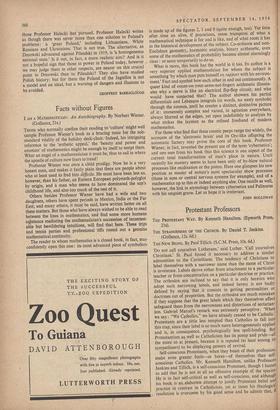Facts without Figures
I AM A MATHEMATICIAN: An Autobiography. By Norbert Wiener. (Gollancz, 21s.) THOSE who normally confine their reading to 'culture' might well sample Professor Wiener's book as a bracing tonic for the sub- standard vitality of the holiday deck-chair. Indeed, his intriguing reference to the `aesthetic appeal,' the 'beauty and power and emotion' of mathematics might be enough by itself to tempt them. What an angel of a mathematician it must be, thus to sail in where the apostle of culture now fears to tread!
Professor Wiener was once a child prodigy. Now he is a very honest man, and makes it fairly plain that there are people about who at least used to find him difticile. He must have been less so, however, than his father, an Eastern European polymath-polyglot by origin, and a man who seems to have dominated the son's childhood life, and also too much of the rest of it.
Others besides Professor Wiener have had a wife and two daughters, others have spent periods in Mexico, India or the Far East; and many others, it must be said, have written better on all these matters. But those who have always wished to be able to read between the lines in mathematics, and find some more humane substance mediating the mathematician's succession of incontest- able but bewildering intuitions, will find that here. These trips and tennis parties and professional tiffs round out a genuine mathematical continuity.
The reader to whom mathematics is a closed book, in fact, may confidently open this one : its most advanced piece of symbolism is made up of the figures 2, 1 and 0 (quite enough, too). Yet time after time an alive, if precarious, sense transpires of what a mathematical technique is for and is like, and of what roots it has in the historical development of the subject. Co-ordinate and non- Euclidean geometry, harmonic analysis, binary arithmetic, even some of the mathematics of probability become almost alarmingly clear: or seem temporarily to do so.
What is more, this book has the world in it too. Its author is a very superior applied mathematician for whom the subject is something 'by which man puts himself en rapport with his environ- ment.' Fact and symbol bow each other in and out continuously. A queer kind of count-on-your-arms-not-fingers arithmetic illumin- ates why a nerve is like an electrical flip-flop circuit; and who would have suspected that? The author showers his partial differentials and Lebesque integrals (in words, no nasty symbols) through the cosmos, until he creates a distinct, distinctive picture of it: immensely complex and varied, in agitation everywhere, always blurred at the edges, yet open indefinitely to analysis by what strikes the layman as the refined freehand of modern mathematics.
For those who find that these cosmic peeps range too widely, the accounts of the `electronic, brain' and its Ore-like offspring the automatic factory may prove the core of this book. Professor Wiener, in fact, invented the present use of the term `cybernetics'; and one sees from his book that this science is one aspect of the current total transformation of man's place in nature. Until recently his mastery seems to have been only of by-blow natural processes like oxidisation or the piston. Here one glimpses his new position as master of nature's most spectacular show processes (those in suns or central nervous systems for example), and of a mathematics up to this or indeed anything else. One recalls as well, however, the link in etymology between cybernetics and Palinurus with his unquiet grave. Let us hope it is irrelevant.


































 Previous page
Previous page